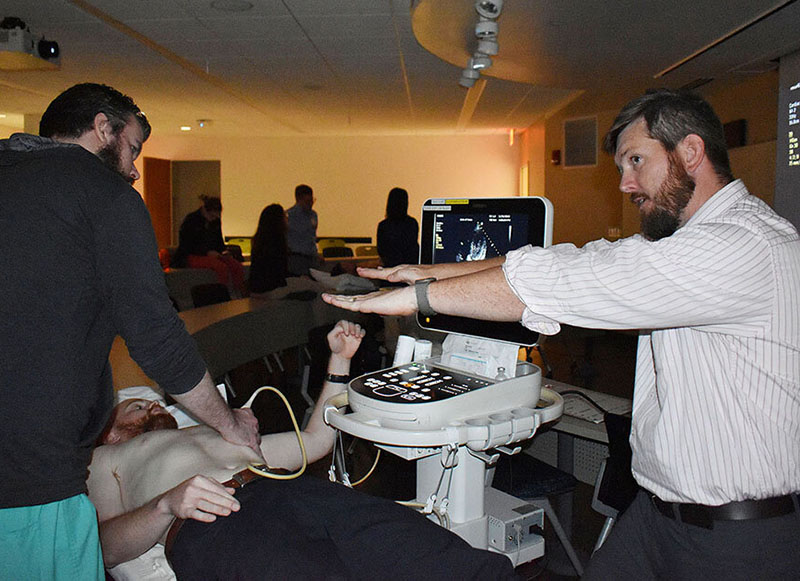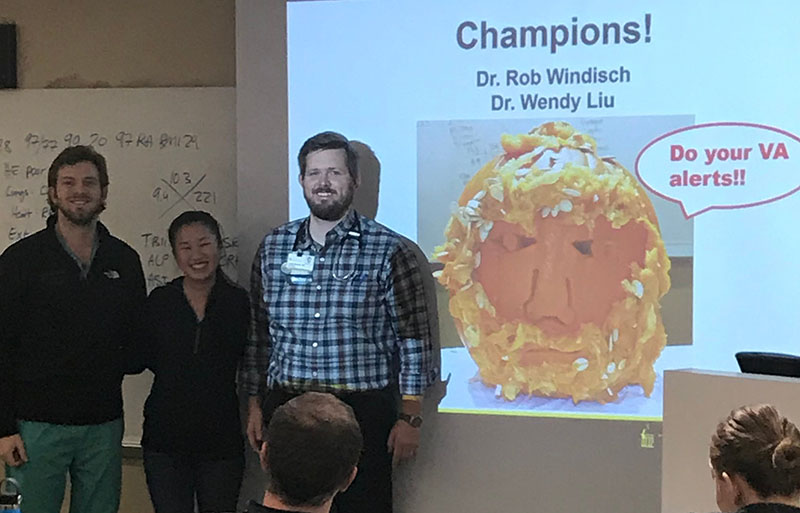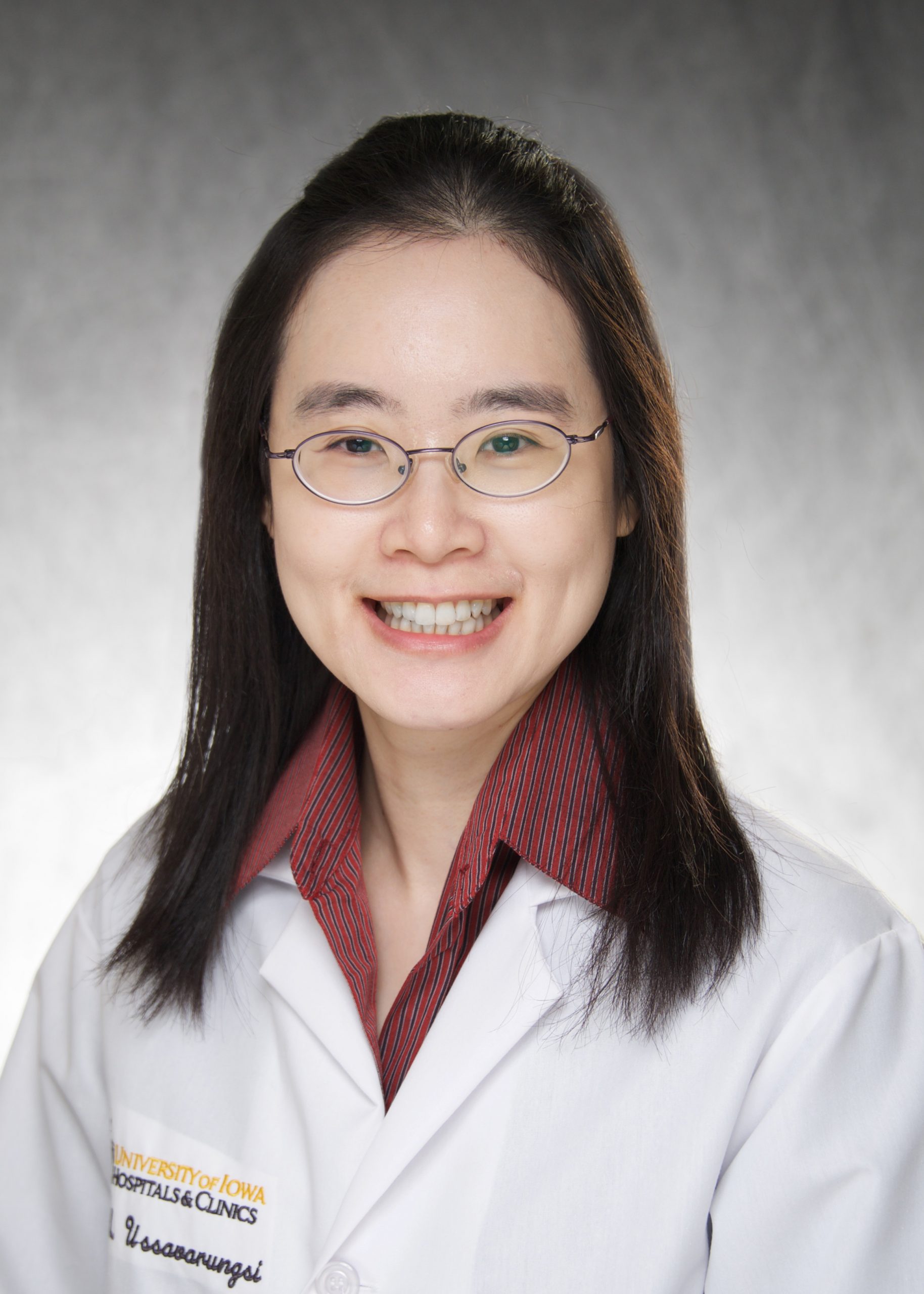After four years of undergraduate study at Northwestern University, Justin Smock, MD, was all packed and ready to head north. He had plans to attend medical school in Wisconsin, but a day before he was supposed to drive to Milwaukee and eight days before the program was supposed to start, he got the call. He was off the waitlist at Iowa’s Carver College of Medicine.
“I knew I loved Iowa,” Smock said. “I knew I wanted to live in Iowa City. The institution has an excellent reputation, and I knew I’d be getting an excellent education. It was sort of a no-brainer. This is always what I wanted. Iowa was always number one on my list.”
Seventeen years later, Iowa is still number one as he has risen through several positions, including medical student, resident, and chief resident. In July 2011, after that chief year, Smock joined the faculty, eventually becoming a clinical associate professor. He has been an associate program director and VA site director for the Internal Medicine Residency Program since 2014.
Not just the science, but the connection
Smock expressed interest in medicine once he realized he could combine his love for science with his passion for helping others. Though he had no physicians in his family, the Decorah-native observed physicians at work when his grandfather was diagnosed with and eventually died from metastatic prostate cancer. The then-16-year-old Smock was not intrigued by the procedural or diagnostic skills required for the job, but rather the relationship between a physician and their patient.
“It was really the bedside skills and humanistic aspects of the profession that made an impression on me,” Smock said. “Seeing how the physicians communicate with the family, how they carry themselves and how they connected with the patients really made an impact.”
Four years after Smock switched courses last minute to attend Iowa, he decided to pursue Internal Medicine residency training and began looking at his options post-graduation. Once again, he did not think he would end up at Iowa. He pictured himself at a private practice, serving as a primary care physician. He looked extensively at community-based Internal Medicine training programs in the upper Midwest. However, Scott Mikesell, DO, who was a chief resident at the time, steered Smock back toward Iowa and the opportunities the Internal Medicine program could provide.
“He sort of made me realize that the volume, the complexity, and the breath of problems that we get to see here would make for a better training experience, regardless of what career path I eventually chose to take,” Smock said.
As a medical student, Smock witnessed the residency program’s culture and found comfort in the supportive atmosphere. He saw residents at two in the morning, on the weekends, after long shifts, and at the beginning of each day.
“You get to see what it’s really like behind the scenes,” Smock said. “I saw the collegiality and support among the residents. I saw how much the program leadership and chief residents really cared about who people were and really wanted to support them and make them successful.”
From mentored to mentoring
Whether resident, chief resident, or faculty, Smock has spent more than a decade working to make the residency program stronger. He credits the many levels of leadership in the department and the program for the improvements he’s seen administered over the years.
“Our leaders make it so clear to our faculty members and our residents how much the trainees matter to the program and the department,” Smock said. “In turn, we are able to recruit outstanding chief residents who are motivated to give back to the program and department. The chiefs are incredibly vital to the culture of our residency program.”
By the time Smock finished his year as chief resident and joined faculty in 2011, he had become more comfortable with educating future physicians and fell in love with helping his students set the foundation for their careers. Smock had been through the program, so he was able to understand the obstacles his junior residents and students were facing. However, at first, he was uncertain if a leadership position in medical education was for him.
“I wasn’t the strongest resident or the strongest medical student,” Smock said. “I just never saw myself as being good enough to be a clinical educator. And then when I got to do those things as a chief, I realized that I did have the knowledge and experience to teach.”
Despite Smock’s own doubts, current associate program director Gwen Beck, MD, and former program director Scott Vogelgesang, MD, spotted Smock’s potential right away. Smock believes Beck’s and Vogelgesang’s mentorship and encouragement helped him find his passion for medical education.
“It was clear from Justin’s first rotations in Internal Medicine that the department needed to recruit him; first to the residency program, then as a chief resident, then a faculty member, and finally an associate residency program director,” Vogelgesang said.
Getting to form the strong physician-patient relationship that first attracted Smock as a 16-year-old to medicine is now a skill Smock possesses, according to Vogelgesang. Not just with his patients but also with his junior colleagues.
“His easy-going interactive style conveys a sense of confidence in his medical care as well as his educational leadership,” Vogelgesang said. “He is an outstanding role-model, physician, and medical educator, and we are lucky to have him in the department.”
The future of bedside medicine
During his year as a chief resident, Smock and his fellow chiefs began developing an ultrasound curriculum. Portable bedside ultrasound technology was becoming more widely available and adopted for both diagnostic and procedural purposes; however, the Internal Medicine residency program did not have a curriculum developed yet.
Eventually, Smock designed an inpatient ultrasound-guided procedure service for the Department of Internal Medicine as a part of his recruitment for his faculty position. Although this was eventually abandoned, the experience gave him a solid foundation and credibility for further development of an ultrasound curriculum when the timing was right.
When the residency program switched to an “X+Y” or 4+1 scheduling system, the program director, Manish Suneja, MD, and the rest of the program leadership saw the opportunity to dedicate time on the Y-week for ultrasound education.
“It created an opportunity for us to do consistent and longitudinal delivery of ultrasound education over the course of a resident’s training,” Smock said. “Before, with our old schedule system, it was kind of sporadic and not every resident got the exact same thing.”
Former chief resident and pulmonary-critical care faculty member Charles Rappaport, MD, and Smock worked together to create the current Point-of-Care Ultrasound Curriculum, which evolves each year depending on the residents’ needs and understanding.
“Ultrasound is important because it is and will continue to be for the foreseeable future a part of many internist’s diagnostic armamentarium,” Smock said.
The consummate coach
As a resident, Smock did not believe he had the skills to be a medical educator, but now he spends his days working alongside residents at the VA Primary Care Clinic, reviewing residency applications, and reviewing his current residents.
Katherine Harris, MD, associate director of the Internal Medicine Residency Program, has known Smock since medical school and vouches for his commitment to the residents and to his colleagues. Smock is always ready to lend a hand.
“His willingness to help out with challenging procedures and general advice while always being approachable and kind is impressive,” Harris said. “He is a wonderful advocate for residents at all times and is dedicated to improving the residency program.”
Although the pandemic prevents residents and program directors from hosting their in-person socials, Smock, his fellow program directors, and the chief residents have tried to offer social support for the first-year residents. To build relationships and provide this support, the program has been hosting a lot of Zoom meetings as well as figuring out ways to meet face-to-face while still staying socially distanced.
“It’s been one of the biggest challenges of this academic year, and the residency program has tried to be proactive about it,” Smock said. “We just have to put more effort into getting to know people because how they are doing and what they are doing outside of the hospital impacts their wellness. That’s important to our program as a whole.”
When Smock is not completing inpatient service at the VA or working alongside his residents, he spends time with his wife and three sons. “My boys keep me busy,” Smock said, “Whether that’s them beating me at Xbox or watching Hawkeye sports on the television.”
Additionally, Smock helps coach his boys’ youth baseball teams. “Hopefully, in the spring, on Saturday and Sunday I’ll be wearing a different ‘hat,’ an actual baseball hat,” Smock said. “That’s what takes up a lot of my time—my boys and my family.”





